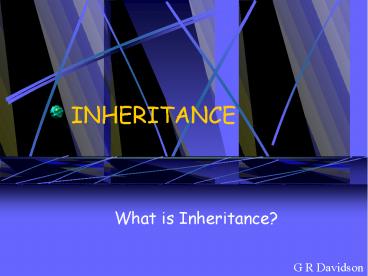INHERITANCE - PowerPoint PPT Presentation
Title:
INHERITANCE
Description:
INHERITANCE What is Inheritance? G R Davidson What is Inheritance? Inherited characteristics are determined by genetic information received from parents. – PowerPoint PPT presentation
Number of Views:286
Avg rating:3.0/5.0
Title: INHERITANCE
1
INHERITANCE
- What is Inheritance?
G R Davidson
2
What is Inheritance?
- Inherited characteristics are determined by
genetic information received from parents. - This information is passed on in the genes on the
chromosomes. - Each organism receives 2 pieces of genetic
information about each characteristic, one from
each parent. - These may be different or the same.
3
e.g. Pea plants can either be tall or dwarf.
Tall
Tall
Tall
Dwarf
Tall
Tall
Dwarf
Dwarf
4
Phenotypes
- For each inherited characteristic an organism
possesses there may be a number of different
forms. - These forms are called PHENOTYPES.
- The phenotype describes the appearance of the
inherited characteristic, e.g. flower colour may
be red, white, etc..
5
Phenotypes
Since each organism receives 2 pieces of
information for this characteristic, we now need
to work out the GENOTYPE.
6
Genotypes
RR
rr
rr
rr
rr
rr
Rr
Rr
rr
rr
Rr
Rr
The GENOTYPE is the set of genes the organism
possesses.
7
Genotypes
- The way in which inherited characteristics are
passed on from parents to offspring, follows a
pattern. - Genetics is the study of these patterns.
- If the two genes in a pair are identical, we say
they are TRUE BREEDING or HOMOZYGOUS e.g. TT or
tt - If they are different, we say they are
HETEROZYGOUS e.g. Tt
8
Alleles
- Different forms of the same gene are called
ALLELES. - E.g. tall and dwarf are different alleles of the
same gene.
9
Chromosomes
- Chromosomes are thread-like structures found in
the nucleus of a cell, which carry inherited
information. - Each normal body cell has 2 matching sets of
these chromosomes. - In humans there are 23 pairs of chromosomes.
10
Gamete Production
- Chromosomes are passed on to the next generation
in the sex cells (gametes). - Each sex cell will contain only 1 of each pair of
chromosomes therefore will only have 23
chromosomes. - This allows it to join up with (fertilise)
another gamete and make the numbers back up to 23
pairs.
11
Genetic Cross
- When we study a characteristic, the first thing
we do is assign it a letter e.g. black would be B
or tall T. - Each characteristic has 2 forms,e.g. tall and
dwarf. - One of these forms will be DOMINANT over the
other, which we say is RECESSIVE. - We assign the dominant trait the capital letter
and the recessive trait the small letter. E.g.
tall is dominant to dwarf, therefore tall will be
T and dwarf will be t.
12
Genetic Cross
- This means a plant with the genotype TT will have
the phenotype TALL - The plant with the genotype Tt will have the
phenotype TALL - The plant with the genotype tt will have the
phenotype dwarf.
13
Ratios of Phenotypes
- The simplest genetic crosses only involve one
characteristic and these are called MONOHYBRID
CROSSES. - The patterns of inheritance can be followed in a
Punnett Square. - E.g.
14
Punnett Square
T tall and t dwarf If we cross a homozygous
tall with a dwarf plant the following punnett
square would be produced.
Gametes T T
t Tt Tt
t Tt Tt
In this cross ALL the offspring are Tt and are
therefore, tall.
15
Punnett Square
If both plants are heterozygous, what would the
square look like?
Gametes
TT
Tt
Tt
tt
16
Sex Chromosomes
Sex in humans is determined by the sex
chromosomes. Females have 2 X chromosomes (XX)
and males have an X and a Y chromosomes (XY).
Gametes
XX
XX
XY
XY
And so, half of the offspring will be female and
the other half male.
17
Monohybrid Crosses
We always set out a cross the same way
Parents (P) Black x Albino
BB
bb
Gametes
B or B
b or b
The gametes for one parent go along the top.
Gametes
Bb
Bb
The gametes for the other parent go down the side.
Bb
Bb
We can then complete the square.
The results of this cross are that all the F1 are
black.
18
Monohybrid Crosses
If we now cross 2 of the F1 generation
Parents (P) Black x Black
Bb
Bb
Gametes
B or b
B or b
The gametes for one parent go along the top.
Gametes
BB
Bb
The gametes for the other parent go down the side.
Bb
bb
We can then complete the square.
The results of this cross are that 3 of the F1
are black and 1 is albino.
19
Monohybrid Crosses
Now try one of your own
Parents (P) Black x Albino
Bb
bb
Gametes
B or b
b or b
The gametes for one parent go along the top.
Gametes
Bb
bb
The gametes for the other parent go down the side.
Bb
bb
We can then complete the square.
The results of this cross are that half of the F1
are black and half are albino.
20
Monohybrid Crosses
- Your answer should always have the parental
genotypes. - Your answer should always have the parental
gametes. - Your answer should always have a completed
punnett square. - Your answer should always have the F1 phenotypes
and the ratio they occur in.































